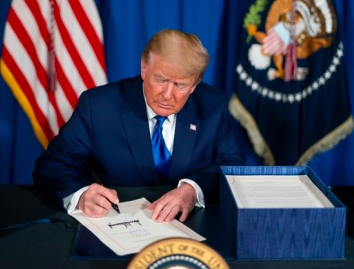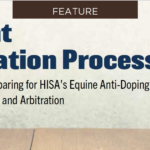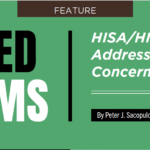Written by Peter J. Sacopulos, JS. Originally posted on: The Trainer Magazine, April 23, 2021
For nearly a decade there has been an effort to have national legislation that governs Thoroughbred horse racing. The first major effort began in 2011, when the Interstate Horseracing Improvement Act of 2011—an attempt to amend the Interstate Horseracing Improvement Act of 1978—was introduced by Senator Tom Udall (D-NM). This bill was not successful. Another effort was advanced when, in 2015, Representative Andy Barr (R-KY) and Representative Paul Tonko (D-NY) introduced the Thoroughbred Horseracing Integrity Act. That same year, Representative Joe Pitt (R-PA) introduced the Horseracing Integrity and Safety Act (the first HISA). It too failed to pass.

SENATOR MITCH MCCONNELL AND MEMBER GROUPS REPRESENTING THE HORSERACING INTEGRITY AND SAFETY ACT MEET AT KEENELAND, AUGUST 2020.
Fast forward to 2020: the Horseracing Integrity and Safety Act is introduced by Representatives Barr and Tonko and passes in the U.S. House of Representatives on September 29, 2020. Senator Mitch McConnell (R-KY) then introduced corresponding legislation in the Senate that was approved.
On December 28, 2020, President Trump signed into law a government funding bill and COVID-relief package. Tucked away into this massive omnibus bill was the Horseracing Integrity and Safety Act (HISA). Since that time, there has been considerable reporting on HISA. Several issues have dominated the discussion of this new legislation. Those include the elimination of furosemide (also known as Lasix) on race day in two-year-olds and Stakes Thoroughbreds for the first three (3) years and, ultimately, in all Thoroughbreds after that.

PRESIDENT DONALD J. TRUMP SIGNS THE CONSOLIDATED APPROPRIATIONS ACT, 2021 WHICH INCLUDED THE INCORPORATION OF THE HORSERACING INTEGRITY AND SAFETY ACT, DECEMBER 2020.
A second issue receiving attention is how the new federal bill that places the United States Anti-Doping Association (USADA) at the head of the recently established Horse Racing Anti-Doping and Medication Control Authority will be funded. Additionally, there has been and continues to be discussion of whether the HISA, which presently only governs Thoroughbred racing, will ultimately include both Standardbred and Quarter Horse racing, as well. However, there is a section of the HISA that is critically important to those in the Thoroughbred industry that has received limited discussion. That is Section 1209 of the HISA. For three primary reasons, Section 1209 of HISA is of particular concern for horsemen. First, it truncates the horsemen’s constitutionally protected right to due process. Second, instead of replacing the state system(s) of regulatory enforcement, the HISA creates a second system of review and enforcement for alleged medication and track safety violations that results in both additional expense and redundancy. Finally, the HISA, as presented, guarantees a multitude of constitutional challenges. Section 1209 of HISA entitled “Review of Final Decisions of the Authority” outlines the disciplinary process. Under the current systems, when a licensee elects to contest an alleged medication or safety violation, the dispute proceeds through an administrative law process followed by a judicial process.






